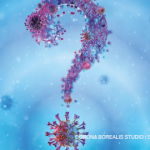It has been noted that patients critically ill with COVID-19 frequently demonstrate several common features, including rapid deterioration one to two weeks after symptom onset, lymphopenia and decreased natural killer (NK) cells in peripheral blood, markedly elevated inflammatory parameters including C-reactive protein (CRP) and pro-inflammatory cytokines (IL-6, TNFα, IL-8), splenic and lymph node atrophy. Clinically, hypercoagulability and multi-organ damage are not uncommon.12 Given these findings, Dr. Calabrese notes that evaluation of of IL-6 inhibition in the treatment of COVID-19 is ongoing. These are already situations in which infected patients demonstrating features of cytokine storm are being treated in the U.S. with tocilizumab and other IL-6 inhibitors.
Bottom Line
Although no pandemic in recent history has quite reached the scope and magnitude of the COVID-19 pandemic, Dr. Calabrese explains that we can look back 100 years and observe the lessons learned from the Spanish influenza pandemic of 1918. Thoughtful, dedicated actions on the part of clinicians, researchers, governments and the population at large can make a difference in helping achieve control of the situation, and it is incumbent upon rheumatologists to play a role in protecting patients with autoimmune disease and helping aid the world in its fight against COVID-19.
Jason Liebowitz, MD, completed his fellowship in rheumatology at Johns Hopkins University, Baltimore. He is now in practice with Arthritis, Rheumatic, & Back Disease Associates, New Jersey.
References
- COVID-19 dashboard by the Center for Systems Science and Engineering (CSSE) at Johns Hopkins University (JHU). 2020.
- Coronavirus disease 2019 (COVID-19). How to protect yourself. Centers for Disease Control and Prevention. 2020.
- COVID-19 Global Rheumatology Alliance. 2020.
- ACR COVID-19 Clinical Guidance Task Force. COVID-19 clinical guidance for patients with rheumatic diseases. 2020 Apr 11.
- Q: Could #ibuprofen worsen disease for people with #COVID19? World Health Organization.
- Liu J, Cao R, Xu M, et al. Hydroxychloroquine, a less toxic derivative of chloroquine, is effective in inhibiting SARS-CoV-2 infection in vitro. Cell Discov. 2020 Mar 18;6:16. doi:10.1038/s41421-020-0156-0
- Yao X, Ye F, Zhang M, et al. In vitro antiviral activity and projection of optimized dosing design of hydroxychloroquine for the treatment of severe acute respiratory syndrome coronavirus 2 (SARS-CoV-2). Clin Infect Dis. 2020 Mar 9;ciaa237. doi:10.1093/cid/ciaa237.
- Gautret P, Lagier JC, Parola P, et al. Hydroxychloroquine and azithromycin as a treatment of COVID-19: results of an open-label non-randomized clinical trial. Int J Antimicrob Agents. 2020 Mar 20;105949. doi:10.1016/j.ijantimicag.2020.105949.
- Schrezenmeier E, Dörner T. Mechanisms of action of hydroxychloroquine and chloroquine: Implications for rheumatology. Nat Rev Rheumatol. 2020 Mar;16(3):155–166. doi:10.1038/s41584-020-0372-x.
- Yazdany J, Kim AHJ. Use of hydroxychloroquine and chloroquine during the COVID-19 pandemic: What every clinician should know. Ann Intern Med. 2020 Mar 31;M20–1334. doi:10.7326/M20-1334.
- FDA approves COVACTA trial for RA drug Actemra in COVID-19 patients. Pharmaceutical Business Review. 2020 Mar 24.
- Zhang W, Zhao Y, Zhang F, et al. The use of anti-inflammatory drugs in the treatment of people with severe coronavirus disease 2019 (COVID-19): The perspectives of clinical immunologists from China. Clin Immunol. 2020 Mar 25;214:108393. doi:10.1016/j.clim.2020.108393.
Updated on April 27, 2020, to reflect current CDC and ACR guidance.



